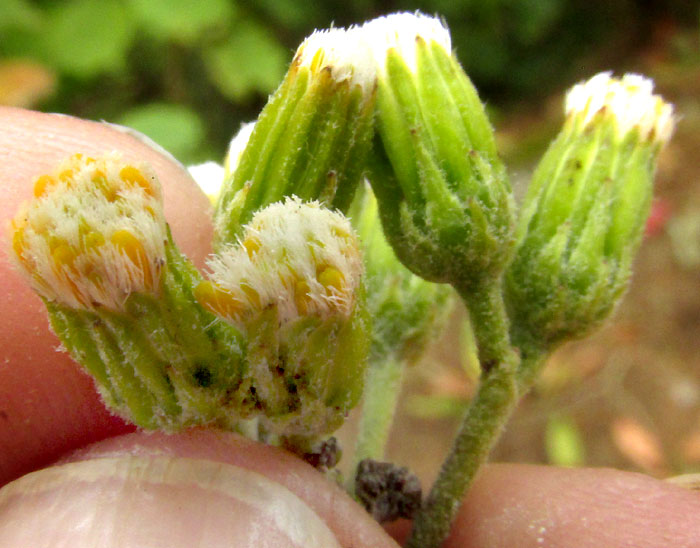Excerpts from Jim Conrad's
Naturalist Newsletter
entry from field notes dated January 19, 2023, taken along steep, one-lane gravel road ascending forested, northeast-facing mountain slope, elevation ±2,380m (7600 ft); bedrock of Cretaceous limestone; on the south side of Pinal de Amoles, Querétaro state, MÉXICO, (N21.134°, W99.629°)
GROUNDSEL

Atop a ridge where clouds must frequently sweep through as cold fog, beside a trail through pine woods, the above shrub about 2m tall (7ft) and consisting of numerous stems arising from the base was conspicuous because of its broad, soft-hairy leaves, and inflorescences of mostly immature flowers. Up close, the individual flowering heads, or capitula, were clearly those of the largest of all plant families, the Aster/Daisy/Sunflower or Composite Family, the Asteraceae:

The capitula bore no petal-like ray florets, which most species in this family to have. These heads contained only tightly packed, immature, cylindrical disc florets not yet open, but with enough of their corollas visible to be seen as yellow. The cup-like, green involucre surrounding each capitulum consisted of scale-like phyllaries of which the inner ones were long, slender, and of about the same height, while the outer, lower ones were much shorter and of different heights among themselves. The green parts were variously covered with white hairs.

Removing phyllaries from one side of a capitulum, one could better see numerous white bristles constituting the pappi atop immature fruits, the pappi later serving as wind-catching parachutes atop the one-seeded, cypsela-type fruits. Also, the florets were not separated from one another by scale-like items called paleae.
In our area, when you see flowering heads like those above, with the involucres' phyllaries mostly tall and slender, and of the same height, especially if the florets are yellow, the best first guess of what you might have should be "groundsel." In the old days groundsels were members of the big genus Senecio, but now Senecio has been split up and several genera produce species known as groundsels.
That complicates the identification process, but luckily the Flora fanerogámica del Valle de México, published in 2010 and dealing with the nearby Central Valley of Mexico, still presents all the groundsels in the genus Senecio. In that work our plant producing only yellow disc florets, growing about 2m tall, bearing roundish leaves and with hairy inflorescence stems, reveals itself as Senecio angulifolius. More recent works call that species ROLDANA ANGULIFOLIA. At this time the genus Roldana comprises about 57 species.
Roldana angulifolia is endemic just to high-elevation Mexico, up to ~4000m (13,100ft), where it's commonly found in forests of pine, oak and fir, and certain disturbed areas.
I read that livestock will eat Roldana angulifolia, and that medicinally it's been used to cure inflammation, wounds, the cold and coughs, but can't find anything more specific. This is another of those common, conspicuous Mexican species appearing on many plant lists for specific areas, and which is often photographed, but little work has been published about it.